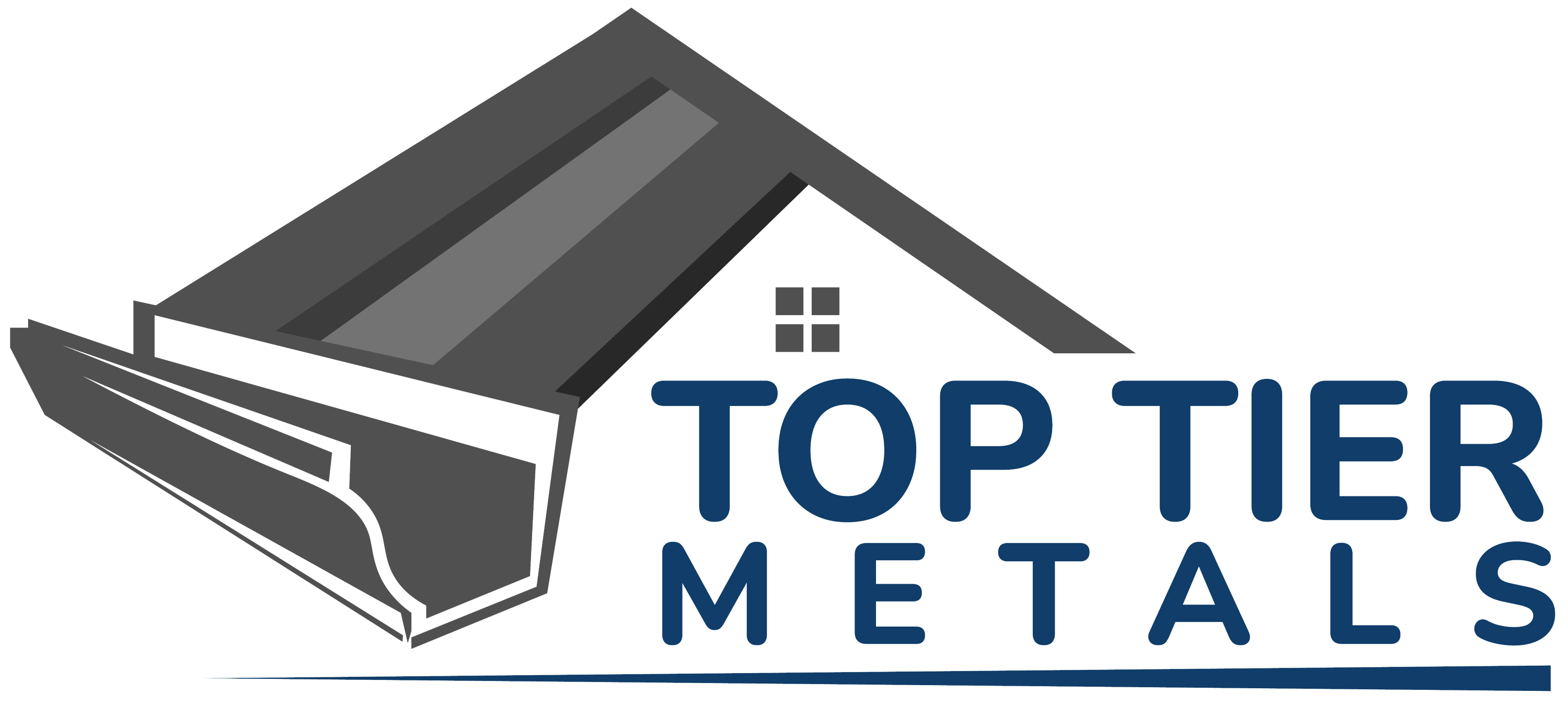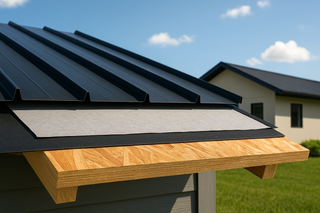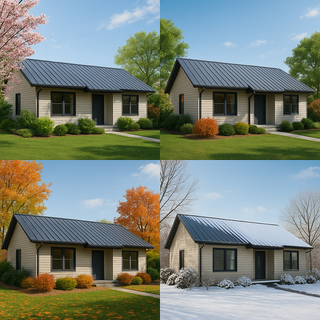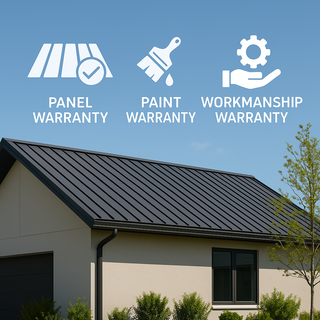Beneath every strong, weather-tight metal roof lies a critical component that homeowners and DIYers often overlook — the underlayment.
While metal roofing panels take the spotlight, it’s the underlayment that quietly protects your home from water, heat, condensation, and structural damage. Choosing the right underlayment for your metal roof isn’t optional — it’s essential.
In this comprehensive guide, Top Tier Metals breaks down the different types of underlayment available, where and when to use them, and how they affect the long-term performance of your roofing system.
1. What Is Roofing Underlayment and Why Does It Matter?
Underlayment is the layer between your roof deck and your metal panels. It provides:
-
Moisture protection from wind-driven rain, ice dams, and leaks
-
Thermal insulation by buffering radiant heat
-
Sound dampening especially important for exposed fastener systems
-
Vapor control to prevent rot, mold, and condensation
-
Fire resistance, depending on material rating
A metal roof without proper underlayment is like insulation without drywall — vulnerable, inefficient, and risky.
2. Main Types of Underlayment for Metal Roofing
Let’s explore the most widely used types of underlayment beneath metal roofs and how they perform in different applications.
A. Synthetic Underlayment (Recommended Standard)
Material: Woven or spun polypropylene or polyethylene with a slip-resistant top layer
Best For: Most residential and light commercial applications
Pros:
-
Lightweight and easy to install
-
High tear resistance
-
Water-resistant and breathable (depending on grade)
-
Doesn’t wrinkle like felt
-
Long UV exposure tolerance (up to 6 months)
Cons:
-
Not completely waterproof — must be paired with proper flashing
-
Higher initial cost than felt
Top Tier Use Case: Great for any standing seam or exposed fastener roof on a home, garage, or outbuilding. We recommend synthetic as the standard underlayment.
B. Ice & Water Shield (Self-Adhered Membrane)
Material: Rubberized asphalt or butyl-based material with peel-and-stick backing
Best For: Roof edges, valleys, penetrations, and cold climates
Pros:
-
Fully waterproof, not just water-resistant
-
Self-sealing around fasteners
-
Ideal for ice dams and wind-driven rain protection
Cons:
-
More expensive per roll
-
Difficult to reposition once placed
-
Can trap vapor if not vented correctly
Top Tier Use Case: Use along eaves, valleys, and around chimneys or skylights — or as full-coverage in low-slope roofs or snowy areas.
C. Felt Paper (Asphalt-Saturated)
Material: Organic mat (often paper) soaked in asphalt
Best For: Budget installs and sheds or unheated buildings
Pros:
-
Low upfront cost
-
Easy to find at most supply stores
-
Class A fire rated
Cons:
-
Tears easily
-
Absorbs water and wrinkles
-
Short UV lifespan (less than 30 days)
Top Tier Use Case: Acceptable for barns or storage buildings where performance is less critical, but not recommended for homes or heated spaces.
D. High-Temp Underlayment
Material: Self-adhering synthetic or modified bitumen, built to withstand high roof temperatures
Best For: Under metal in hot climates, or under solar panel arrays
Pros:
-
Resists temperatures above 250°F
-
Maintains integrity under dark metal panels
-
Often used with premium standing seam roofs
Cons:
-
More expensive
-
Overkill for northern climates or shaded roofs
Top Tier Use Case: Excellent for Florida, Texas, Arizona, and other high-sun states — especially under black or dark bronze roofs.
3. Regional Underlayment Recommendations
Your climate plays a major role in selecting the right underlayment:
| Region | Suggested System |
|---|---|
| Midwest/Northeast | Synthetic + Ice & Water at eaves & valleys |
| Southeast | Synthetic + High-temp in full coverage |
| Southwest | High-temp or cool roof reflective underlay |
| Pacific Northwest | Fully synthetic with added ridge venting |
| Coastal Areas | High-temp + vapor barrier under aluminum |
4. What Underlayment Should Go Under Standing Seam Roofs?
For concealed fastener systems like standing seam, the underlayment must accommodate thermal movement and moisture sealing.
Top Recommended System:
-
Synthetic underlayment full coverage
-
Ice & Water Shield at valleys and penetrations
-
High-temp upgrade if using black or matte panels
This setup provides clean surface adhesion for clips and avoids trapped heat from dark coatings.
5. What About Exposed Fastener Systems?
Exposed fastener panels benefit from strong tear resistance in the underlayment because of more penetrations.
Best Practices:
-
Use reinforced synthetic underlayment
-
Apply Ice & Water Shield around any roof penetrations (vents, chimneys, skylights)
-
Lap seams correctly with cap nails, not staples
This ensures longevity and weather-tight performance despite the higher number of fasteners used.
6. Special Conditions That May Require Custom Underlayment
Some projects call for more than a one-size-fits-all approach. Here are a few edge cases:
Low-Slope Roofs (<3:12):
-
Always use full-coverage Ice & Water Shield or high-temp underlayment.
-
Metal roofs on low-slope systems are more prone to water intrusion.
Heated Attics or Metal over Insulated Decks:
-
Include a vapor retarder between insulation and deck to prevent condensation.
-
Consider breathable synthetic underlayment to manage trapped moisture.
Noise Reduction Needs:
-
Double underlayment layers or insulated synthetic products can help absorb sound.
7. Underlayment Installation Best Practices
Even the best product fails with poor install. Follow these guidelines:
-
Lap each row 4–6 inches, or follow manufacturer requirements
-
Use cap nails or screws — avoid staples which can tear through
-
Install underlayment tight and flat, with no wrinkles or sagging
-
Seal penetrations using boots or membrane patching
-
Never leave underlayment exposed beyond its UV rating
8. Does Underlayment Affect Warranty?
Yes — and it can void warranties if you use the wrong one.
Most panel manufacturers require:
-
Synthetic or high-temp underlayment
-
Proper sealing at fasteners and edges
-
Underlayment compatibility with the panel coating (no chemical reaction)
At Top Tier Metals, we’ll tell you exactly which underlayment preserves your metal panel warranty and what combinations we recommend based on your panel profile.
Final Thoughts: Don’t Overlook What’s Underneath
Metal roofing is built to last — but only if what’s underneath it is up to the same standard.
Choosing the right underlayment protects your investment, prevents future headaches, and ensures your metal roof performs like it should for the next 40–70 years.
Top Tier Metals is here to help you select the right panel and underlayment combination for your location, roof type, and budget — whether you're a homeowner, DIYer, or contractor.
Need Help Choosing the Right Underlayment?
Contact our team for personalized recommendations and bundle pricing.
👉 Contact Us | 📞 Call Now






